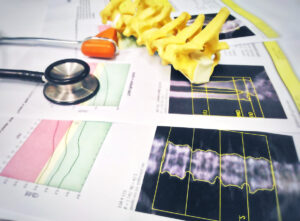Excess alcohol has all kinds of associated problems in terms of physical and mental health. One of the areas that doesn’t get much attention is alcohol and the bone. There is evidence that excess alcohol may have a negative influence on bone mineral density and the risk of osteoporosis related fractures. A meta-analysis was done to explore the influence of alcohol and the risk of osteoporosis.
 Data bases were searched to provide information to see if there was a dose-response relationship between alcohol intake and bone mineral density (BMD) and risk of osteoporotic fractures. A total of 11 studies including 46,916 individuals with BMD assessment and 8 studies including 240,871 individuals with risk of fracture analysis were included.
Data bases were searched to provide information to see if there was a dose-response relationship between alcohol intake and bone mineral density (BMD) and risk of osteoporotic fractures. A total of 11 studies including 46,916 individuals with BMD assessment and 8 studies including 240,871 individuals with risk of fracture analysis were included.
Compared to non-drinkers, the consumption of up to two standard alcohol drinks per day was correlated with higher lumbar spine (low back) and femoral neck (a part of the hip) BMD values, while up to one standard drink of alcohol was correlated with higher hip compared to no alcohol consumption. A higher risk of hip fractures was found starting from three standard drinks of alcohol per day and more so if 4 drinks per day. The risk steadily increased with higher intake of alcohol.
Commentary:
Firstly, you might be confused. Higher alcohol consumption is definitely associated with a higher risk of osteoporotic fractures. But 1-2 drinks per day, or what is considered lower doses, the role of alcohol gets fuzzy, given that BMD was higher in these drinkers compared to non-drinkers. The study has some problems: Firstly, this is an observational design of the original studies which does not allow us to really conclude a cause and effect relationship. Secondly, since the alcohol intake was assessed during interviews, this may not reflect early intake or lifelong exposure. In addition, the interview and assessment of alcohol consumed did not identify drinking patterns. The study also failed to make clear the differences in men and women or women pre vs. post menopause. Lastly, the increase in BMD values in the light drinkers compared to non-drinkers was not clinically relevant. While it is tempting to conclude that there is clinical improvement in BMD values in lighter drinkers, the more accurate conclusion is no effect – positive or negative. compared to non-drinkers.
There are several mechanisms that provide the rationale for the negative effects of excessive intake of alcohol on bone health. We know that chronic alcohol consumption negatively alters bone remodeling, the process of bone formation and bone resorption. To be specific, alcohol impairs the bone microarchitecture and affects the thickness of the bone that is 50% of the hip, as well as trabecular bone, which makes up 90% of the kind of bone in the lumbar spine. Another indirect mechanism has to do with how alcohol overconsumption affects hormone regulation including leptin, vitamin D and parathyroid hormone all of which influence bone metabolism. Excess alcohol intake may also impair nutrient absorption, including the malabsorption of calcium from the intestines, which then leads to lower levels of serum calcium and calcium deficiency. In women, over consumption of alcohol can decrease estrogens and/or alter estrogen metabolism. Less estrogen stimulation of bone, especially after menopause, can lead to more bone loss due to a faster pace of bone turnover in favor of resorption (bone loss) vs. formation.
In terms of the big picture, alcohol consumption can be a cause or risk factor for depression, breast cancer, heart disease, stroke, hypertension, heart attacks, liver disease and osteoporosis.
Reference: Godos J, Giampieri F, Chisari E, et al. Alcohol consumption, bone mineral density, and risk of osteoporotic fractures: A dose-response meta-analysis. Int J Envciron. Res. Public Health 2022, 19:1515

